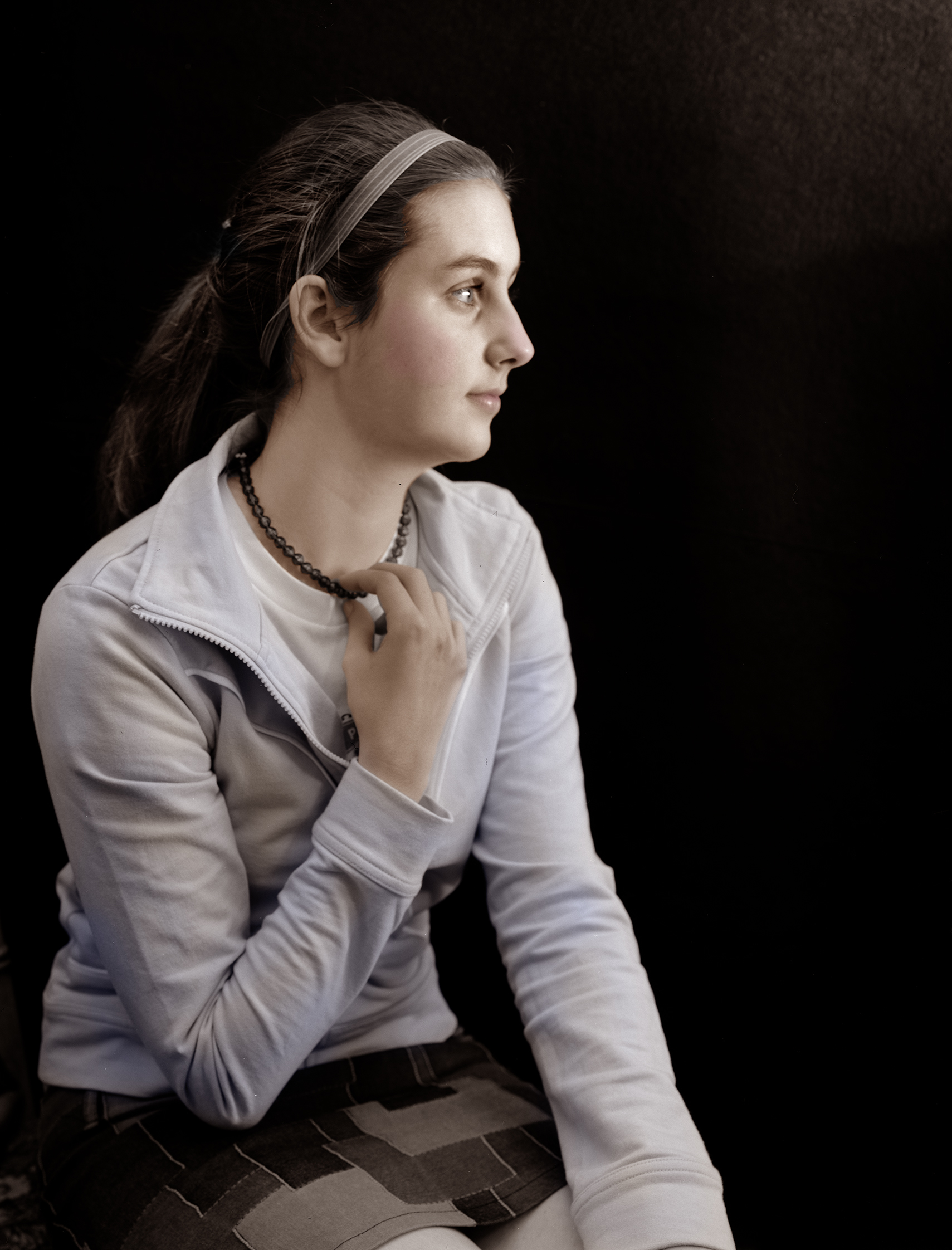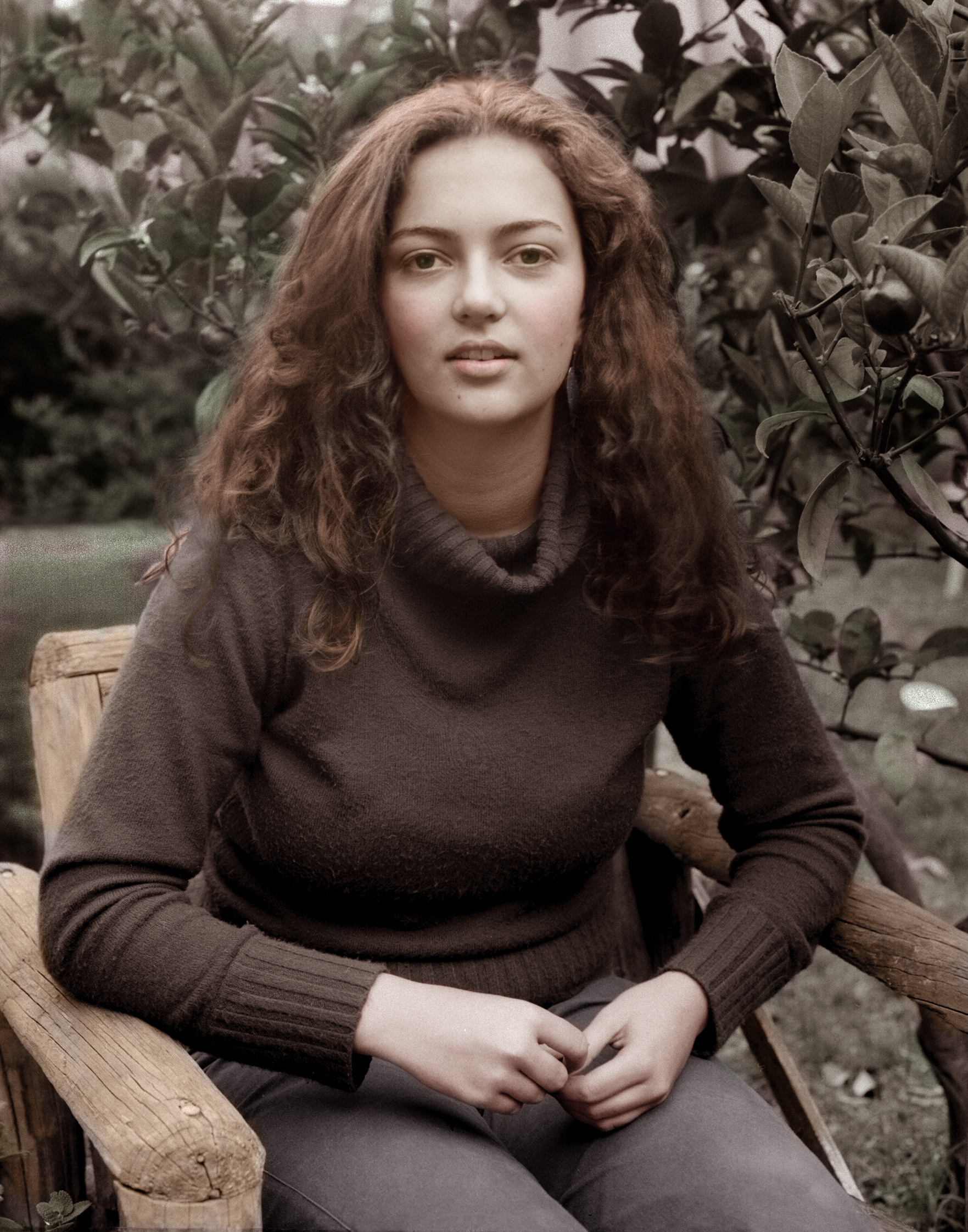Bews on looking at Green
In this powerful and personal reflection, local writer and theatre artist Samantha Bews explores her response to a series of hand-coloured photographs of teenagers by Janina Green.

Bews on Looking at Green
Sometimes art kicks you in the guts then rolls you over for a kiss.
I go to CAM to choose a piece to write a Reflection about. I dismiss Green’s teenage portraits outright and spend a couple of hours word-sketching a moody landscape piece that is anchored by a solitary tree. But as I leave the gallery I feel strangely dissatisfied. Something is pulling at the loose, dark threads of my being. By the time I reach the studio I know what it is. The Teenagers. I hate them.
Why do they provoke such a violent reaction in me?
“Why?”
The big question to bring to any adventure with art …
I return to the gallery a second time, drag a chair in front of the portraits and, notebook in hand, sit.

The great gift of writing is that it can take me to those base, impossible, un-“sensible” places rather quickly.
I write and discover I hate these portraits because as a teenager these are the sorts of girls I longed to be. What I see are slim, intelligent, high-achieving young women, the ones parents and teachers love, or worse, admire. This is nothing like my experience of teenage-dom. I was fat, pock-marked and disengaged. I sloshed like a leaky swamp from one prescribed event to the next—school, home, bed.
I was nothing like these images of vitality and possibility.
But the beautiful thing about art is, if you allow yourself your dumb questions and irrational emotions, if you stay a moment longer, it will continue to reveal itself to you.
As I sit with the darkness the portraits have reawakened, I also see beyond that darkness. New questions rise. Why hand-coloured?
Wikipedia tells me that hand-colouring was used from almost the start of the invention of photography and peaked in its popularity between 1900 and 1940 (my association with it is images from the 1950s). Portraits of teenage girls from those times come to mind, touched up as they were to emphasise comeliness, suitability, wholesomeness. I see that by applying this historical technique to contemporary portraits Janina Green is bringing into play a conversation across the two eras. How has the way we see teenage girls changed between the times? What prejudices do we now project onto teenage girls? What expectations? What is a teenage girl?
My thinking shifts and I imagine the action of hand-colouring these portraits. In an age of ubiquitous coloured imagery, the artist has chosen to give time to these portraits. She has wondered about, experimented with and applied colour by hand. She has made delicate, steady strokes with her brush onto the fibre-based paper. The attention the artist has brought to her subjects acts on me as a kind of mercy.
My knot of hate unravels. I see that in my great misery as a teenager, I simply wanted to be seen. Seen as more than the black blob of misery I felt and to have that intense misery understood—seen. But I was lost, mired in a difficult past, and in many ways had absented myself from the picture. These generous portraits render the subjects fully, colourfully, intriguingly present.
The longer I sit with the portraits, the more I move past my own prejudice and finally see the people in front of me. More (and more humane) questions come to the fore: Who are you? What sorrows do you face? What lights your fire? Why can’t you sit still?! What are you thinking (quantum physics or the politics of algorithms)?
I leave the gallery having attended to the artwork, and through this chance meeting, was given leave to attend to the wounded self. I have worked on the art and the art has worked on me. This is the chemistry of creation. As thrilling as a first kiss.
Samantha Bews
October 2020

Bews on looking at Green
Sometimes art kicks you in the guts then rolls you over for a kiss.
I go to CAM to choose a piece to write a Reflection about. I dismiss Green’s teenage portraits outright and spend a couple of hours word-sketching a moody landscape piece that is anchored by a solitary tree. But as I leave the gallery I feel strangely dissatisfied. Something is pulling at the loose, dark threads of my being. By the time I reach the studio I know what it is. The Teenagers. I hate them.
Why do they provoke such a violent reaction in me?
“Why?”
The big question to bring to any adventure with art …
I return to the gallery a second time, drag a chair in front of the portraits and, notebook in hand, sit
Bews on looking at Green
Sometimes art kicks you in the guts then rolls you over for a kiss.
I go to CAM to choose a piece to write a Reflection about. I dismiss Green’s teenage portraits outright and spend a couple of hours word-sketching a moody landscape piece that is anchored by a solitary tree. But as I leave the gallery I feel strangely dissatisfied. Something is pulling at the loose, dark threads of my being. By the time I reach the studio I know what it is. The Teenagers. I hate them.
Why do they provoke such a violent reaction in me?
“Why?”
The big question to bring to any adventure with art …
I return to the gallery a second time, drag a chair in front of the portraits and, notebook in hand, sit
Bews on looking at Green
Sometimes art kicks you in the guts then rolls you over for a kiss.
I go to CAM to choose a piece to write a Reflection about. I dismiss Green’s teenage portraits outright and spend a couple of hours word-sketching a moody landscape piece that is anchored by a solitary tree. But as I leave the gallery I feel strangely dissatisfied. Something is pulling at the loose, dark threads of my being. By the time I reach the studio I know what it is. The Teenagers. I hate them.
Why do they provoke such a violent reaction in me?
“Why?”
The big question to bring to any adventure with art …
I return to the gallery a second time, drag a chair in front of the portraits and, notebook in hand, sit.
Bews on looking at Green
Sometimes art kicks you in the guts then rolls you over for a kiss.
I go to CAM to choose a piece to write a Reflection about. I dismiss Green’s teenage portraits outright and spend a couple of hours word-sketching a moody landscape piece that is anchored by a solitary tree. But as I leave the gallery I feel strangely dissatisfied. Something is pulling at the loose, dark threads of my being. By the time I reach the studio I know what it is. The Teenagers. I hate them.
Why do they provoke such a violent reaction in me?
“Why?”
The big question to bring to any adventure with art …
I return to the gallery a second time, drag a chair in front of the portraits and, notebook in hand, sit.
Bews on looking at Green
Sometimes art kicks you in the guts then rolls you over for a kiss.
I go to CAM to choose a piece to write a Reflection about. I dismiss Green’s teenage portraits outright and spend a couple of hours word-sketching a moody landscape piece that is anchored by a solitary tree. But as I leave the gallery I feel strangely dissatisfied. Something is pulling at the loose, dark threads of my being. By the time I reach the studio I know what it is. The Teenagers. I hate them.
Why do they provoke such a violent reaction in me?
“Why?”
The big question to bring to any adventure with art …
I return to the gallery a second time, drag a chair in front of the portraits and, notebook in hand, sit.